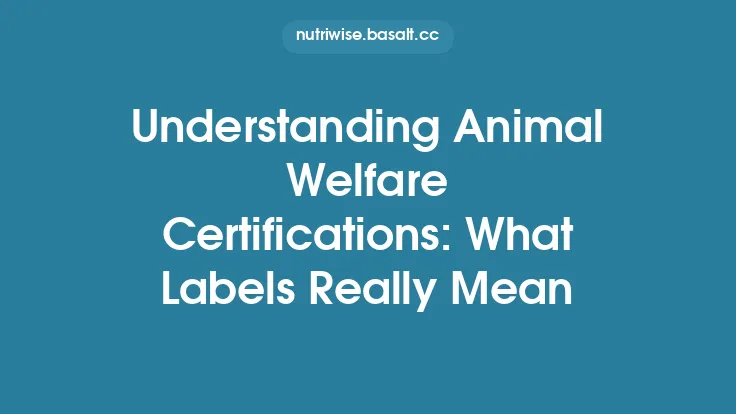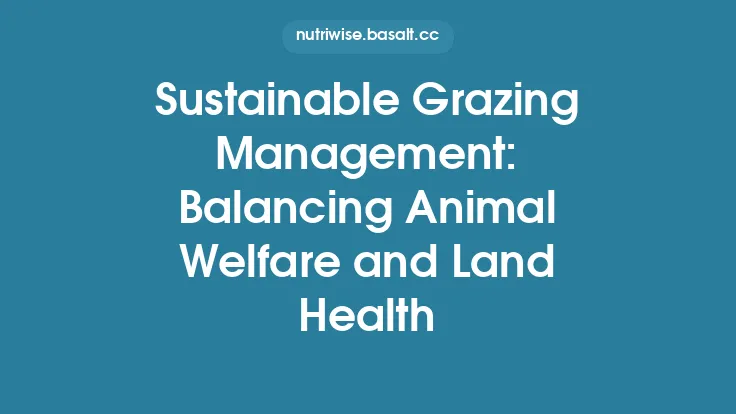Implementing Animal Welfare Audits: Steps for Continuous Improvement
Animal welfare audits have become a cornerstone for farms and livestock operations that aim to demonstrate responsible stewardship, meet regulatory expectations, and satisfy increasingly discerning consumers. While the concept of an audit may seem straightforward—checking boxes against a set of standards—the reality is a dynamic, data‑driven process that must evolve alongside advances in science, technology, and societal expectations. This article walks through the essential steps for establishing, executing, and continuously refining animal welfare audits, providing a practical roadmap that can be adapted to operations of any scale.
Why Audits Matter for Animal Welfare
Audits serve several interrelated purposes that go beyond simple compliance:
- Objective Assessment – By applying a consistent set of criteria, audits provide an unbiased snapshot of current practices, revealing gaps that internal staff may overlook.
- Risk Management – Systematic evaluation helps identify welfare‑related risks (e.g., overcrowding, inadequate ventilation) before they translate into disease outbreaks, production losses, or reputational damage.
- Data‑Driven Decision Making – Quantitative audit results feed directly into management dashboards, enabling evidence‑based prioritization of investments and interventions.
- Stakeholder Confidence – Transparent audit outcomes reassure regulators, retailers, and consumers that the operation adheres to recognized welfare standards.
- Continuous Improvement – Audits are the feedback loop that drives the Plan‑Do‑Check‑Act (PDCA) cycle, ensuring that welfare practices evolve rather than stagnate.
Establishing a Robust Audit Framework
A solid framework sets the foundation for repeatable, credible audits. The following components should be defined before the first field visit:
| Component | Description | Key Considerations |
|---|---|---|
| Scope | Geographic boundaries, species, production stages (e.g., breeding, finishing) | Align scope with business objectives and regulatory jurisdictions |
| Frequency | How often each audit is performed (annual, semi‑annual, continuous) | Balance thoroughness with operational disruption |
| Audit Type | Internal, third‑party, or hybrid | Determine independence level required for stakeholder trust |
| Reference Standards | Welfare guidelines, scientific literature, industry best practices | Choose standards that are current, peer‑reviewed, and applicable |
| Performance Indicators | Quantitative metrics (e.g., space allowance, injury rates) and qualitative observations | Ensure indicators are SMART (Specific, Measurable, Achievable, Relevant, Time‑bound) |
| Governance Structure | Roles and responsibilities for audit planning, execution, reporting, and follow‑up | Assign clear accountability to avoid “ownership gaps” |
Document this framework in a living “Audit Charter” that can be reviewed and updated annually.
Designing Effective Audit Criteria and Indicators
The heart of any audit lies in the criteria against which performance is measured. Effective criteria share these attributes:
- Scientific Basis – Grounded in peer‑reviewed research on animal behavior, physiology, and health.
- Measurability – Expressed in units that can be reliably recorded (e.g., meters of space per animal, percentage of animals with lameness scores ≤ 1).
- Relevance – Directly linked to welfare outcomes that matter to the operation (e.g., mortality, stress biomarkers).
- Feasibility – Collectible without excessive labor or equipment costs.
Example Indicator Sets
| Welfare Domain | Indicator | Target | Data Source |
|---|---|---|---|
| Housing | Minimum floor space per animal | ≥ 0.8 m² (species‑specific) | Facility layout plans, on‑site measurements |
| Environmental Comfort | Ambient temperature range during peak season | 15–22 °C (species‑specific) | Automated climate sensors |
| Health | Incidence of lameness (score ≥ 2) | ≤ 2 % of herd | Routine health checks, scoring sheets |
| Behavior | Frequency of abnormal repetitive behaviors | < 5 % of observed animals | Video analysis, ethogram scoring |
| Management Practices | Time between handling events per animal | ≥ 48 h | Handling logs, RFID timestamps |
When developing indicators, involve multidisciplinary experts (veterinarians, ethologists, engineers) to ensure comprehensive coverage.
Selecting and Training Auditors
The credibility of an audit hinges on the competence of its auditors. Whether you employ internal staff or contract external specialists, follow these steps:
- Qualification Matrix – Define minimum education (e.g., degree in animal science), experience (e.g., ≥ 3 years in livestock management), and certifications (e.g., animal welfare assessment training).
- Standardized Training Program – Include modules on:
- Interpretation of audit criteria
- Observation techniques (e.g., blind spot avoidance)
- Data recording protocols (digital forms, GPS tagging)
- Ethical considerations (conflict of interest, confidentiality)
- Calibration Exercises – Conduct joint field visits where auditors independently assess the same herd and then compare results to quantify inter‑rater reliability (target Cohen’s κ ≥ 0.8).
- Continuing Education – Schedule annual refresher courses and updates on emerging welfare science.
Document auditor qualifications and training records in a centralized “Auditor Registry” for audit traceability.
Data Collection and Documentation Practices
Accurate, auditable data is the lifeblood of the process. Adopt the following best practices:
- Digital Data Capture – Use tablet‑based forms with built‑in validation rules (e.g., range checks) to reduce transcription errors.
- Time‑Stamped Entries – Every observation should be automatically time‑stamped and, where possible, geo‑tagged.
- Standardized Coding – Apply a uniform coding scheme for animal identifiers (e.g., RFID tag numbers) and welfare events (e.g., “LAME‑02”).
- Secure Storage – Store data in a cloud‑based, encrypted repository with role‑based access controls.
- Version Control – Maintain a changelog for any modifications to data collection tools or indicator definitions.
A well‑structured data architecture enables seamless integration with analytics platforms and facilitates longitudinal trend analysis.
Conducting the Audit: Methodologies and Tools
Audits can be performed using a blend of observational, instrumental, and statistical methods:
- Walk‑Through Inspections – Systematic traversal of facilities using a pre‑defined route checklist to ensure all zones are examined.
- Spot‑Check Sampling – Randomly select a statistically valid subset of animals for detailed health and behavior scoring (e.g., 5 % of the herd).
- Environmental Monitoring – Deploy sensors for temperature, humidity, ammonia, and light intensity; download data logs for compliance verification.
- Video Surveillance – Install fixed cameras in high‑traffic areas; use computer‑vision algorithms to quantify activity levels and detect abnormal behaviors.
- Biomarker Sampling – Where feasible, collect non‑invasive samples (e.g., fecal cortisol) to provide physiological corroboration of stress levels.
Combine these methods into a “Multi‑Modal Audit Protocol” that balances depth of insight with operational practicality.
Analyzing Findings and Prioritizing Actions
Raw audit data must be transformed into actionable intelligence:
- Scoring Matrix – Convert each indicator into a weighted score (e.g., 0–5) and aggregate to produce a composite welfare index for each facility.
- Root‑Cause Analysis – For any indicator that falls below target, apply tools such as the “5 Whys” or Fishbone diagrams to uncover underlying drivers.
- Risk Prioritization – Use a risk matrix (likelihood × impact) to rank issues; focus first on high‑impact, high‑likelihood problems (e.g., inadequate ventilation leading to respiratory disease).
- Action Planning – Draft corrective action plans (CAPs) that specify:
- What will be done
- Who is responsible
- Timeline for completion
- Success metrics
Document the analysis and CAPs in a “Audit Findings Report” that is distributed to all relevant stakeholders within a defined timeframe (typically 10 business days post‑audit).
Implementing Corrective and Preventive Measures
Effective implementation hinges on clear communication and robust project management:
- Assign Ownership – Link each CAP to a specific manager or team with authority to allocate resources.
- Resource Allocation – Budget for necessary capital (e.g., ventilation upgrades) and labor (e.g., additional handling staff).
- Standard Operating Procedure (SOP) Updates – Revise SOPs to embed new practices; ensure they are version‑controlled and accessible.
- Training Roll‑Out – Conduct targeted training sessions for staff impacted by the changes.
- Verification Audits – Schedule follow‑up inspections within 30–90 days to confirm that corrective actions are fully implemented and effective.
Preventive measures involve proactive steps such as predictive maintenance schedules for equipment and early‑warning dashboards for welfare indicators.
Monitoring Progress and Ensuring Accountability
Continuous monitoring transforms one‑off fixes into sustained improvement:
- Key Performance Indicator (KPI) Dashboards – Real‑time visualizations of welfare metrics (e.g., daily lameness incidence) accessible to managers and auditors.
- Monthly Review Meetings – Cross‑functional teams discuss KPI trends, address emerging issues, and adjust CAPs as needed.
- Performance Incentives – Align employee bonuses or farm certification status with achievement of welfare targets.
- Audit Trail – Maintain a complete log of all data entries, changes, and approvals to support traceability and external scrutiny.
By institutionalizing these mechanisms, the organization creates a culture where accountability is built into daily operations.
Leveraging Technology for Ongoing Improvement
Emerging technologies can dramatically enhance audit efficiency and insight:
- Internet of Things (IoT) Sensors – Continuous monitoring of micro‑climate, water quality, and animal movement.
- Artificial Intelligence (AI) Analytics – Machine‑learning models that predict welfare breaches based on historical data patterns.
- Blockchain for Data Integrity – Immutable recording of audit results, ensuring tamper‑proof traceability across the supply chain.
- Mobile Apps with Offline Capability – Allow auditors to capture data in remote locations without network connectivity, syncing later.
Investing in a modular technology stack enables scalability and future‑proofing as new tools become available.
Embedding a Continuous Improvement Culture
Audits are most effective when they are perceived as learning opportunities rather than punitive inspections. To foster this mindset:
- Leadership Commitment – Executives should regularly communicate the strategic importance of animal welfare and allocate resources accordingly.
- Transparent Communication – Share audit results (both successes and gaps) with all staff, celebrating improvements and openly discussing challenges.
- Employee Involvement – Encourage frontline workers to submit observations or improvement ideas through suggestion platforms.
- Learning Loops – Incorporate lessons learned from each audit cycle into training curricula and SOP revisions.
A culture that values curiosity, openness, and shared responsibility turns audits into engines of innovation.
Benchmarking and External Validation
While internal audits provide deep operational insight, external benchmarking adds credibility and perspective:
- Industry Benchmarks – Compare composite welfare indices against sector averages or best‑in‑class performers.
- Third‑Party Certification Audits – Align internal audit criteria with those of recognized certification bodies to streamline dual‑audit processes.
- Peer Audits – Participate in collaborative audit exchanges with other farms to share best practices and identify blind spots.
External validation not only strengthens market positioning but also highlights opportunities for further refinement.
Communicating Results to Stakeholders
Effective communication ensures that audit outcomes translate into trust and market advantage:
- Internal Stakeholders – Use concise executive summaries, visual dashboards, and action‑item lists to keep management informed.
- Regulators – Submit compliance reports in the prescribed format, including evidence of corrective actions.
- Consumers and Retail Partners – Publish high‑level welfare performance metrics on websites, product packaging, or sustainability reports, emphasizing transparency.
- Investors – Integrate welfare audit results into ESG (Environmental, Social, Governance) disclosures, demonstrating risk mitigation and responsible stewardship.
Tailor the depth and format of communication to the audience’s needs while maintaining factual accuracy.
Reviewing and Updating the Audit System
The final step in the audit lifecycle is a systematic review of the audit system itself:
- Annual System Review – Evaluate the relevance of audit criteria, indicator thresholds, and frequency based on new scientific evidence and regulatory changes.
- Feedback Incorporation – Gather input from auditors, farm staff, and external partners to identify pain points and improvement ideas.
- Process Optimization – Apply Lean or Six Sigma techniques to streamline audit workflows, reduce redundancies, and improve data quality.
- Documentation Refresh – Update the Audit Charter, SOPs, and training materials to reflect any changes.
By treating the audit framework as a living system, organizations ensure that animal welfare remains a dynamic, continuously advancing priority.
In summary, implementing animal welfare audits is a multifaceted endeavor that blends scientific rigor, robust data management, skilled personnel, and a culture of perpetual learning. By following the structured steps outlined above—defining a clear framework, designing measurable criteria, training competent auditors, leveraging technology, and embedding continuous improvement—livestock operations can not only meet regulatory and market expectations but also set new standards for ethical, sustainable animal care. The result is a resilient enterprise where animal welfare, productivity, and consumer confidence reinforce each other in a virtuous cycle.





